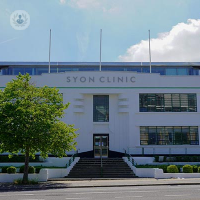What is a hip replacement?
A hip replacement is a type of surgery in which a degenerated hip is replaced with an artificial joint.
There are different kinds of hip prosthesis which depend on how the affected bones are replaced:
- total hip replacement
- revision prosthesis
- hip resurfacing

Why would you do it?
A hip replacement is used to alleviate pain and restore function in patients who have not responded to previous treatment (rest, rehabilitation, and anti-inflammatories).
Replacing the hip with a prosthesis is recommended in cases where there is hip osteoarthritis, rheumatoid arthritis, or a hip fracture.
What does it involve?
To carry out the procedure general or spinal (from the waist down) anaesthetic is used. When replacing the prosthesis, general anaesthetic is used as the procedure tends to take more time.
The materials used in a hip prosthesis are intended to make movement be as similar as possible to normal joint movements. Different types of metal are used to make the implants, including: stainless steel, cobalt alloys, chromium, titanium. Some replacements are made of plastic – normally polyethylene, which is highly durable and resistant to wear and tear.
The surgery usually takes between 60 and 90 minutes to complete.
How to prepare for a replacement
A preoperative study is carried out before the procedure and includes:
- blood tests
- chest X-ray
- echocardiogram
In some cases, additional tests may be needed, such as a pulmonary ventilation test or allergy tests.
Finally, you will have a meeting with the anaesthetist to check your suitability for a general anaesthetic or epidural.
Post-operative care
After the operation, you are likely to need to use crutches for four to six weeks. Rehabilitation is a long process but you will be enrolled in a program to help you get moving again and gradually build up your strength.
To help the area recover:
- wash the surgical wound and gently massage in moisturiser twice a day
- keep the leg elevated whenever possible
- sit on chairs that are high and have armrests or sit on firm sofas.
- use comfortable shoes that give good foot support
- follow a balanced diet that is high in iron and fibre and with plenty of fluids
- take extra care at home, removing carpets, cable, or furniture that could cause a fall and be careful on wet floors
It can also help to sleep face up and with a pillow between the legs and not to sleep on their side. When going to the toilet, you can use a raise toilet seat temporarily to avoid excessive joint flexion.
Finally, it is important to seek urgent medical help if you experience the following symptoms:
- a heavy ache in the hip
- pain and tenderness in one of your legs
- breathlessness or chest pain
- a high temperature
- hip pain even at rest
Hip replacement
Professor Lee Jeys - Orthopaedic surgery
Created on: 11-29-2013
Updated on: 09-20-2023
Edited by: Kate Forristal
What is a hip replacement?
A hip replacement is a type of surgery in which a degenerated hip is replaced with an artificial joint.
There are different kinds of hip prosthesis which depend on how the affected bones are replaced:
- total hip replacement
- revision prosthesis
- hip resurfacing

Why would you do it?
A hip replacement is used to alleviate pain and restore function in patients who have not responded to previous treatment (rest, rehabilitation, and anti-inflammatories).
Replacing the hip with a prosthesis is recommended in cases where there is hip osteoarthritis, rheumatoid arthritis, or a hip fracture.
What does it involve?
To carry out the procedure general or spinal (from the waist down) anaesthetic is used. When replacing the prosthesis, general anaesthetic is used as the procedure tends to take more time.
The materials used in a hip prosthesis are intended to make movement be as similar as possible to normal joint movements. Different types of metal are used to make the implants, including: stainless steel, cobalt alloys, chromium, titanium. Some replacements are made of plastic – normally polyethylene, which is highly durable and resistant to wear and tear.
The surgery usually takes between 60 and 90 minutes to complete.
How to prepare for a replacement
A preoperative study is carried out before the procedure and includes:
- blood tests
- chest X-ray
- echocardiogram
In some cases, additional tests may be needed, such as a pulmonary ventilation test or allergy tests.
Finally, you will have a meeting with the anaesthetist to check your suitability for a general anaesthetic or epidural.
Post-operative care
After the operation, you are likely to need to use crutches for four to six weeks. Rehabilitation is a long process but you will be enrolled in a program to help you get moving again and gradually build up your strength.
To help the area recover:
- wash the surgical wound and gently massage in moisturiser twice a day
- keep the leg elevated whenever possible
- sit on chairs that are high and have armrests or sit on firm sofas.
- use comfortable shoes that give good foot support
- follow a balanced diet that is high in iron and fibre and with plenty of fluids
- take extra care at home, removing carpets, cable, or furniture that could cause a fall and be careful on wet floors
It can also help to sleep face up and with a pillow between the legs and not to sleep on their side. When going to the toilet, you can use a raise toilet seat temporarily to avoid excessive joint flexion.
Finally, it is important to seek urgent medical help if you experience the following symptoms:
- a heavy ache in the hip
- pain and tenderness in one of your legs
- breathlessness or chest pain
- a high temperature
- hip pain even at rest


How to know if your hip replacement is becoming loose (and what to do about it)
By Mr Adam Cohen
2025-01-29
How does a hip replacement become loose? Mr Adam Cohen explains how this can happen, how common it is and also the necessary treatment. See more


Hip replacement approaches: which is best for me?
By Mr Stephen Veitch
2025-01-29
Mr Stephen Veitch discusses the various surgical approaches for hip replacement, explaining the advantages and disadvantages of each approach See more


All you need to know about hip replacement in young adults
By Mr Adam Cohen
2025-01-29
Nowadays, it is becoming more common for the younger, sporty generation to have hip replacements. We've asked one of our expert orthopaedic surgeons Mr Adam Cohen just why a hip replacement may be necessary, how long a hip replacement lasts in a young person and what life will be like after surgery. See more


Custom hip replacement: What are the advantages?
By Mr Khalid Malik
2025-01-29
In recent years, advancements in medical technology have revolutionised the field of orthopaedic surgery, particularly in the realm of hip replacements. One of the latest innovations in this domain is custom hip replacement surgery, offering tailored solutions for individuals suffering from debilitating hip conditions. In this article, leading consultant trauma and orthopaedic surgeon Mr Khalid Malik delve into what custom hip replacement entails, its advantages, and who might benefit from this procedure. See more
Experts in Hip replacement
-
Mr Manoj Sood
Orthopaedic surgeryExpert in:
- Hip replacement
- Knee replacement
- Anterior cruciate ligament
- Sports injuries
- Knee cartilage replacement
- Tendon injuries
-
Mr Pramod Achan
Orthopaedic surgeryExpert in:
- Hip
- Hip prosthesis
- Hip arthroscopy
- Sports surgery
- Hip replacement
- Knee arthroscopy
-
Mr William Bartlett
Orthopaedic surgeryExpert in:
- Sports injuries
- Hip replacement
- Knee replacement
- Hip pain
- Hip arthroscopy
- Knee arthroscopy
-
Ms Sarah Muirhead-Allwood
Orthopaedic surgeryExpert in:
- Hip replacement
- Hip prosthesis
- Arthroplasty
- Osteoarthritis of the hip
- Anterior hip replacement
-
Mr James Donaldson
Orthopaedic surgeryExpert in:
- Hip replacement
- Knee replacement
- Robotic surgery
- Revision hip replacement
- Revision knee replacement
- Knee arthroscopy
- See all

Syon Clinic - part of Circle Health Group
Syon Clinic - part of Circle Health Group
941 Great West Rd, Brentford TW8 9DU
No existe teléfono en el centro.
By using the telephone number provided by TOP DOCTORS, you automatically agree to let us use your phone number for statistical and commercial purposes. For further information, read our Privacy Policy
Top Doctors

The Royal Free Hospital
The Royal Free Hospital
Pond Street, Hampstead. NW3 2QG
No existe teléfono en el centro.
By using the telephone number provided by TOP DOCTORS, you automatically agree to let us use your phone number for statistical and commercial purposes. For further information, read our Privacy Policy
Top Doctors

Chelsea Outpatients Diagnostic Centre
Chelsea Outpatients Diagnostic Centre
Chelsea Outpatient Centre, 280 King's Rd, London SW3 5AW
No existe teléfono en el centro.
By using the telephone number provided by TOP DOCTORS, you automatically agree to let us use your phone number for statistical and commercial purposes. For further information, read our Privacy Policy
Top Doctors
-
Syon Clinic - part of Circle Health Group
941 Great West Rd, Brentford TW8 9DU, West LondonExpert in:
- Allergies nose and ears
- Allergy Dermatitis
- Allergy
- Clinical analysis
- Anxiety
- Digestive
-
The Royal Free Hospital
Pond Street, Hampstead. NW3 2QG, Central LondonExpert in:
- General Surgery
- Orthopaedic surgery
- Robotic Surgery
- Dermatology
- Obstetrics and Gynaecology
- Paediatrics
-
Chelsea Outpatients Diagnostic Centre
Chelsea Outpatient Centre, 280 King's Rd, London SW3 5AW, Central LondonExpert in:
- Physiotherapy
- General practice
- Health check up
- Emergency Service 24h
- Trauma
- See all
- Most viewed diseases, medical tests, and treatments
- Osteoporosis
- Ulnar nerve entrapment
- Peripheral nerve block
- Peripheral neuropathy
- Joint pain
- Lumbar herniated disc
- Spinal surgery
- Minimal access surgery (keyhole surgery)
- Shoulder pain
- Botulinum toxin (Botox™)








